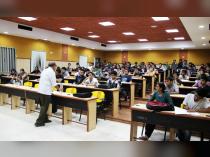Need syllabus for MCA entrance exam in vit
-
1 Answer
-
Markdown Live Preview
Reset
Copy
It is recommended to go through the official syllabus in detail and refer to the recommended textbooks and resources for proper preparation of the entrance examination.
VIT Master's Entrance Examination (VITMEE) for MCA
The VITMEE for the MCA programme tests candidates on a number of subjects. The syllabus is categorized into two major heads Mathematics, Computer Awareness and English Communication.
1. Mathematics and Computer Awareness:
This section tests knowledge in the following areas
Mathematics:
Algebra; Basic operations, expansion, factorization, quadratic equations, indices, logarithms, progressions, bin...more
Similar Questions for you
Students can check VITEEE entrance exam date on its official website. Also, students who have done VIT BTech slot booking and received admit card can check their specific allotted exam date. The VIT entrance exam date and time will be mentioned in VITEEE hall ticket.
No — VIT-AP does not admit or offer free seat under EAPCET counselling and you cannot admit to VIT-AP without VITEEE (or management quota).
The clear explanation is described below:
1. Is VIT-AP EAMCET/ EAPCET rankable?
No.
VIT-AP does not engage in Andhra Pradesh EAPCET counselling.
They do not believe in EAMCET ranks to B.Tech admissions.
The admissions of VIT-AP are largely by way of:
VITEEE (compulsory in merit seats of B.Tech)
Direct/Management quota (increased fee)
Scholarships depend on the VITEEE ranking / board marks (unlimited)
Your EAPCET rank is therefore not accepted to be admitted to VIT-AP.
2. Is it possible to secur
The placement package details have not been disclosed on the official website. Some details are available on Shiksha students review page. As per that, the highest salary offered to the students in recent placements was INR 63 LPA. The average salary offered was INR 7.3 LPA.
The VIT-AP School of Business has hosted a large share of recruiters from varied sectors. Some of the well-known companies that participated in the recent drives included Hitachi, Indian Oil, Microsoft, Google, Amazon, Deloitte and many others.
According to the students reviews on Shiksha.com, the VIT-AP School of Business, VIT-AP University average package for the recent placements was around INR 7.3 LPA. The salary details are not disclosed on the official website. As soon as any information is available, it will be updated here.
Taking an Exam? Selecting a College?
Get authentic answers from experts, students and alumni that you won't find anywhere else
Sign Up on ShikshaOn Shiksha, get access to
- 66k Colleges
- 1.2k Exams
- 680k Reviews
- 1800k Answers


